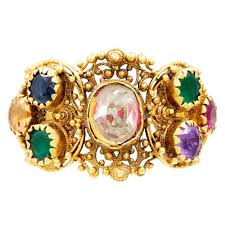Acrostics, is a word which is used for spelling a message, using the first letter of a series of words. Acrostics were once commonly used in poems and letters to convey secret messages in Victorian times. An acrostic poem is a cryptographic form in which the initial letter of each line spells out a word, often the subject of the poem or the name of the person to whom the poem is dedicated.
The first known acrostics date back to ancient times: the name acrostic was first used to describe the prophecies of the Erithraean Sibyl, which were written on leaves arranged so that the first letter on each leaf formed a word.
There is also evidence that acrostics were once commonly used in poems and letters to convey secret messages in the Victorian times. Acrostics are quite unique. A Victorian filigree diamond ring today is a much sought after piece.
We have a number of acrostic poems from the Elizabethan, Romantic and Victorian periods in our library here at About Poetry:
Hymn I, Of Astraea by Sir John Davies (1599)
Hymn III, To the Spring by Sir John Davies (1599)
Hymn VII, To the Rose by Sir John Davies (1599)
London by William Blake (1794)
An Acrostic by Edgar Allan Poe (1829)
A Boat Beneath a Sunny Sky by Lewis Carroll (1871)
Not only flowers have been used as a secret or silent language to communicate messages; gemstones as well have represented communiqus meant only for the wearer and sender. This type of jewelry is known as acrostic as the first letters of specifically selected gems spell out a saying, a wish or a greeting.
Acrostic jewelry is thought to have begun in France during the late 18th to early 19th century and became exceedingly popular in the Victorian era when formalized rules of etiquette were in place.
Victorian Era Acrostic Jewellery
Acrostic jewellery first appeared in 17th century England and France. Combinations of gems were set into rings, brooches and bracelets, so that when arranged, the first letters of the name of each gem spelled a message or sentiment. The most popular acrostic piece in Victorian times was the Regard ring, created using the precious stones of; Ruby, Emerald, Garnet, Amethyst, Ruby and Diamond.

The first letter of each stone spelled a word when put together. There was a wide variety of materials used in the jewelry: turquoise, coral, pearls, agate, tortoiseshell, cut steel, sterling, gold and various grades of gold, jet, French jet (black glass), lava, onyx and paste, low carat gold markings (9 carat) and gun metal “blackened steel.”
Jewellers sometimes resorted to what they called, cheats, to ensure the correct message was created in arranging an acrostic piece. For example, they used alternative names for some of their gems, such as the Chinese name Yu for Jade (using the Jade gem for the letter Y). Modern jewellers often use simpler cheats such as Yellow Zircon for the letter Y, and Fire Opal for the letter F.
